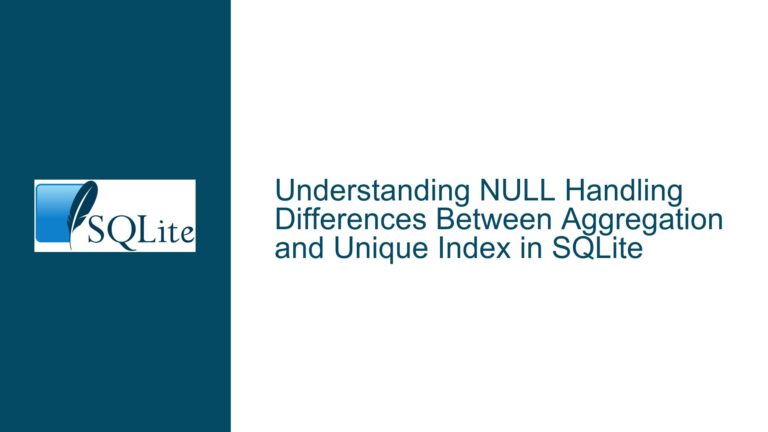Handling Nulls, Blanks, and Zero Values in SQLite Queries
Identifying and Filtering Nulls, Blanks, and Zero Values in SQLite
When working with SQLite databases, one of the most common challenges is handling nulls, blanks, and zero values in queries. These values can represent missing, undefined, or default data, and they often require special handling to ensure accurate query results. In this guide, we will explore the nuances of identifying and filtering these values, particularly in the context of a view that needs to extract specific records based on conditions involving nulls, blanks, or zeros.
Understanding Nulls, Blanks, and Zero Values in SQLite
In SQLite, null represents the absence of a value, while an empty string ('') is a blank value. Zero (0) is a numeric value that can be used to represent a default or placeholder value. Each of these has distinct characteristics and implications for querying:
- Null: A null value indicates that no data exists for that field. It is not the same as an empty string or zero. Nulls are often used to represent missing or unknown information.
- Blank: A blank value is an empty string (
''). It is a valid string value but contains no characters. Blanks can be the result of data entry or data processing. - Zero: Zero is a numeric value. It can be used to represent a default value, a placeholder, or a specific condition in the data.
The challenge arises when you need to filter records based on these values. For example, you might want to retrieve all records where a specific column is either null, blank, or zero. This requires a clear understanding of how SQLite handles these values and how to construct queries to account for them.
Common Pitfalls When Querying Nulls, Blanks, and Zero Values
One of the most common mistakes when querying nulls, blanks, and zero values is assuming that they can be treated interchangeably. For example, a query that checks for null values will not return records with blank or zero values, and vice versa. This can lead to incomplete or incorrect results.
Another common issue is the presence of hidden characters or unexpected data formats. For instance, a field that appears to be blank might contain invisible characters such as spaces, tabs, or non-breaking spaces. These characters can affect the results of your queries, especially if you are using string comparison functions.
Additionally, the data type of the column can influence how nulls, blanks, and zero values are handled. In SQLite, columns can store values of different types, and the type affinity of a column can affect how values are compared and filtered. For example, a column with a numeric affinity will treat zero as a numeric value, while a column with a text affinity will treat zero as a string.
Constructing Queries to Handle Nulls, Blanks, and Zero Values
To accurately filter records based on nulls, blanks, and zero values, you need to construct queries that explicitly account for each type of value. Here are some key considerations and techniques:
Checking for Null Values: To check for null values, use the
IS NULLoperator. For example,WHERE MotherID IS NULLwill return records where theMotherIDcolumn is null.Checking for Blank Values: To check for blank values, use the
=operator with an empty string. For example,WHERE MotherID = ''will return records where theMotherIDcolumn is an empty string.Checking for Zero Values: To check for zero values, use the
=operator with zero. For example,WHERE MotherID = 0will return records where theMotherIDcolumn is zero.Combining Conditions: To combine conditions for nulls, blanks, and zero values, use the
ORoperator. For example,WHERE MotherID IS NULL OR MotherID = '' OR MotherID = 0will return records where theMotherIDcolumn is either null, blank, or zero.Handling Hidden Characters: If you suspect that blank values might contain hidden characters, use the
TRIMfunction to remove leading and trailing spaces before comparing. For example,WHERE TRIM(MotherID) = ''will return records where theMotherIDcolumn is effectively blank after trimming.Using
typeofandhexfor Debugging: If you are unsure about the type or content of a column, use thetypeofandhexfunctions to inspect the values. For example,SELECT MotherID, typeof(MotherID), hex(MotherID) FROM tablenamewill return the value, type, and hexadecimal representation of theMotherIDcolumn, which can help you identify hidden characters or unexpected data formats.
Example Query for Filtering Nulls, Blanks, and Zero Values
Let’s consider a practical example where you have a table named Family with columns PersonID, FatherID, and MotherID. You want to retrieve all PersonID values where either FatherID or MotherID is null, blank, or zero. Here’s how you can construct the query:
SELECT PersonID
FROM Family
WHERE (FatherID IS NULL OR FatherID = '' OR FatherID = 0)
OR (MotherID IS NULL OR MotherID = '' OR MotherID = 0);
This query will return the PersonID values for records where either FatherID or MotherID is null, blank, or zero. Note that the conditions for FatherID and MotherID are combined using the OR operator to ensure that records matching any of the conditions are included in the result.
Advanced Techniques for Handling Complex Data
In some cases, the data might be more complex, with hidden characters, mixed data types, or international characters. Here are some advanced techniques to handle such scenarios:
Using
TRIMwith Multiple Characters: If your data contains various types of whitespace characters (e.g., spaces, tabs, non-breaking spaces), you can use theTRIMfunction with a list of characters to remove them. For example:SELECT PersonID FROM Family WHERE TRIM(MotherID, CHAR(9) || CHAR(10) || CHAR(13) || CHAR(32) || CHAR(160)) = '';This query removes tabs (
CHAR(9)), line feeds (CHAR(10)), carriage returns (CHAR(13)), spaces (CHAR(32)), and non-breaking spaces (CHAR(160)) from theMotherIDcolumn before checking if it is blank.Handling Unicode Spaces: If your data contains Unicode space characters, you can extend the
TRIMfunction to include these characters. For example:SELECT PersonID FROM Family WHERE TRIM(MotherID, CHAR(9) || CHAR(10) || CHAR(13) || CHAR(32) || CHAR(160) || CHAR(8192)) = '';This query includes the Unicode space character
CHAR(8192)in the list of characters to trim.Using
COALESCEfor Default Values: If you want to treat null values as blanks or zeros in your query, you can use theCOALESCEfunction to provide a default value. For example:SELECT PersonID FROM Family WHERE COALESCE(FatherID, '') = '' OR COALESCE(MotherID, 0) = 0;This query treats null values in
FatherIDas blanks and null values inMotherIDas zeros.
Best Practices for Querying Nulls, Blanks, and Zero Values
To ensure accurate and efficient queries when dealing with nulls, blanks, and zero values, follow these best practices:
Understand Your Data: Before constructing queries, inspect your data to understand the types of values present in each column. Use functions like
typeof,length, andhexto identify hidden characters or unexpected data formats.Use Explicit Conditions: Always use explicit conditions to check for nulls, blanks, and zero values. Avoid relying on implicit type conversions or assumptions about the data.
Combine Conditions Carefully: When combining conditions for nulls, blanks, and zero values, use the
ORoperator to ensure that records matching any of the conditions are included in the result.Handle Hidden Characters: If your data might contain hidden characters, use the
TRIMfunction to remove them before comparing values.Test Your Queries: Always test your queries with a variety of data scenarios to ensure that they return the expected results. This is especially important when dealing with nulls, blanks, and zero values, as these can be easily overlooked.
Conclusion
Handling nulls, blanks, and zero values in SQLite queries requires a clear understanding of how these values are represented and how to construct queries to account for them. By using explicit conditions, combining conditions carefully, and handling hidden characters, you can ensure that your queries return accurate and complete results. Additionally, understanding your data and testing your queries thoroughly are essential best practices for working with these types of values in SQLite.
By following the techniques and best practices outlined in this guide, you can confidently handle nulls, blanks, and zero values in your SQLite queries, ensuring that your data is accurately filtered and processed. Whether you are working with simple or complex data, these strategies will help you achieve the desired results and avoid common pitfalls.






